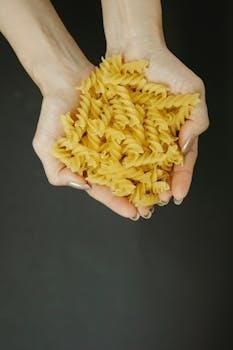o positive blood type diet pdf
The O positive blood type diet, a component of the broader blood type diet concept, proposes that individuals with type O positive blood should tailor their eating habits. This approach aligns food choices with ancestral hunter-gatherer diets.
Overview of the Blood Type Diet Concept
The blood type diet, popularized by Dr. Peter D’Adamo, suggests that one’s ABO blood group influences the optimal food choices for health and well-being. The core idea revolves around the notion that different blood types process foods differently due to unique antigens and reactions. This diet proposes that aligning your diet with your blood type can improve digestion, boost energy levels, and even reduce the risk of chronic diseases.
The diet posits that blood type O, considered the oldest, should follow a high-protein, meat-centric approach, mirroring the diets of early hunter-gatherers. Conversely, other blood types have different dietary recommendations. This concept has gained considerable attention, although scientific validation remains a subject of debate. It’s crucial to approach this diet with careful consideration and consult healthcare professionals before making significant dietary changes.
The Core Principles Behind the O Positive Diet
The O positive diet emphasizes a high-protein intake, reflecting the dietary habits of early humans. The diet prioritizes lean meats, fish, and vegetables, while limiting grains, legumes, and dairy. This approach is rooted in the belief that individuals with type O blood are genetically predisposed to thrive on a diet rich in animal protein and low in carbohydrates.
The central premise is that type O individuals may have difficulty digesting certain lectins found in grains and legumes, leading to digestive issues and other health problems. Therefore, these foods are restricted to minimize potential negative reactions. The diet also encourages regular physical activity, aligning with the active lifestyle of hunter-gatherers. Adherents believe this dietary approach optimizes energy levels, promotes weight management, and supports overall well-being by working in harmony with one’s genetic makeup.

Foods Recommended for O Positive Blood Type
The O positive blood type diet recommends a focus on high-protein sources like meat and fish, alongside specific fruits and vegetables. It generally promotes choices mirroring ancestral eating habits.
High-Protein Foods⁚ Meat and Fish Choices
For individuals adhering to the O positive blood type diet, high-protein foods, particularly meat and fish, are considered cornerstones. The diet’s foundation lies in the belief that those with type O blood thrive on a diet reminiscent of their hunter-gatherer ancestors, who consumed significant amounts of animal protein.
Lean meats such as beef, lamb, and venison are often recommended, as they are believed to be easily digested and efficiently utilized by individuals with type O positive blood. Fish, especially cold-water varieties like salmon, tuna, and cod, are also encouraged due to their high protein content and beneficial omega-3 fatty acids.
However, the diet typically advises moderation or avoidance of certain processed meats and seafood high in mercury. The emphasis remains on consuming natural, unprocessed sources of protein to optimize health and well-being according to the principles of the O positive blood type diet.
Fruits and Vegetables⁚ Optimal Selections
The O positive blood type diet emphasizes the inclusion of specific fruits and vegetables to optimize health. While the diet focuses on protein, certain produce selections are considered more beneficial than others. Dark leafy greens, like spinach, kale, and broccoli, are highly recommended due to their rich nutrient profiles and potential digestive benefits for individuals with type O blood.
Fruits such as berries, plums, and figs are also often encouraged, as they are believed to be well-tolerated and provide essential vitamins and antioxidants. However, certain fruits and vegetables, such as cabbage, Brussels sprouts, and some melons, may be restricted due to purported digestive issues or interference with thyroid function.
The selection of optimal fruits and vegetables for the O positive blood type diet aims to complement the high-protein focus, ensuring a balanced intake of essential nutrients while minimizing potential digestive discomfort based on the diet’s principles.

Foods to Limit or Avoid on the O Positive Diet
The O positive blood type diet suggests limiting or avoiding certain food groups. These restrictions are based on the belief that these foods may negatively impact digestion and overall health.
Grains and Legumes⁚ Restrictions and Alternatives
The O positive blood type diet often advises limiting the consumption of grains and legumes. This recommendation stems from the idea that individuals with type O blood may have difficulty digesting these foods efficiently. The diet suggests that certain components in grains and legumes can interfere with digestion and nutrient absorption, potentially leading to digestive discomfort or other health issues.
However, completely eliminating grains and legumes might not be necessary or desirable for everyone. The key is to focus on moderation and select alternatives that are more easily digestible. Some suggested alternatives for grains include gluten-free options like rice. For legumes, smaller portions or specific types may be better tolerated. It’s essential to listen to your body and observe how you react to different grains and legumes to determine the best approach for your individual needs. Consulting with a healthcare professional or registered dietitian can provide personalized guidance on incorporating grains and legumes into your O positive blood type diet.
Dairy Products⁚ Considerations and Substitutions
The O positive blood type diet typically recommends limiting or avoiding dairy products. This restriction is based on the theory that individuals with type O blood may not process dairy efficiently, potentially leading to digestive issues or inflammation. The diet suggests that the proteins in dairy can be difficult for those with type O blood to digest, possibly causing discomfort or hindering nutrient absorption.
However, it’s important to note that individual tolerance to dairy varies. Some individuals with O positive blood may be able to consume certain dairy products in moderation without experiencing adverse effects. It’s crucial to pay attention to how your body reacts to different types of dairy.
For those who choose to limit or avoid dairy, numerous substitutes are available. Almond milk, coconut milk, soy milk, and rice milk are all popular non-dairy alternatives that can be used in place of cow’s milk. Additionally, there are dairy-free yogurt and cheese options made from plant-based ingredients. Experimenting with these substitutes can help you find suitable alternatives that meet your nutritional needs and preferences while adhering to the principles of the O positive blood type diet. Consulting with a healthcare professional or registered dietitian can provide personalized guidance on dairy consumption and substitutions.

Potential Benefits of the O Positive Diet
Proponents of the O positive diet suggest potential benefits like improved weight management, increased energy levels, and better digestive health. These claims are based on the diet’s emphasis on protein and limited grains.
Weight Management and Energy Levels
The O positive blood type diet, rich in lean proteins and vegetables, is often touted for its potential to aid in weight management. The emphasis on these food groups, while restricting grains and legumes, may contribute to a feeling of satiety and reduce overall calorie intake, indirectly supporting weight loss efforts. Furthermore, the diet’s focus on nutrient-dense foods is believed to positively impact energy levels.
By prioritizing protein sources and limiting processed carbohydrates, the O positive diet aims to stabilize blood sugar levels. This can lead to more sustained energy throughout the day, preventing the energy crashes associated with diets high in refined sugars and carbohydrates. Adherents also report feeling less sluggish and more alert, which they attribute to the diet’s emphasis on whole, unprocessed foods. However, individual results may vary, and consulting a healthcare professional is recommended before making significant dietary changes to manage weight or improve energy levels.
Digestive Health and Nutrient Absorption
Proponents of the O positive blood type diet suggest that adhering to its guidelines can positively influence digestive health and nutrient absorption. The diet’s emphasis on lean proteins and vegetables is thought to be easily digestible for individuals with type O blood, aligning with the ancestral eating patterns of hunter-gatherers. By limiting grains and legumes, which some believe can be difficult to digest, the diet aims to reduce digestive discomfort such as bloating and gas.
Furthermore, the focus on whole, unprocessed foods in the O positive diet may enhance nutrient absorption. These foods are rich in vitamins, minerals, and enzymes that support optimal digestive function. By avoiding processed foods and additives, the diet seeks to minimize potential irritants that can interfere with nutrient uptake. However, it’s important to note that scientific evidence supporting these claims is limited, and individual experiences may vary. A balanced and varied diet, tailored to individual needs and health conditions, remains crucial for optimal digestive health and nutrient absorption.
Scientific Evidence and Criticisms
The blood type diet, including the O positive variant, faces scientific scrutiny. Studies generally haven’t validated its claims. Experts often cite a lack of robust evidence supporting the diet’s purported health benefits.
Studies Supporting or Refuting the Blood Type Diet
Research examining the blood type diet, including its application to O positive individuals, presents a mixed landscape. Some studies suggest potential benefits from diets rich in fruits and vegetables, regardless of blood type, aligning with general healthy eating recommendations. However, these studies do not specifically validate the blood type diet’s core principles.
Conversely, other research directly challenges the blood type diet’s efficacy. These studies find no significant correlation between blood type and the purported health benefits claimed by proponents of the diet. They highlight the lack of scientific evidence supporting the idea that tailoring one’s diet to their blood type leads to improved health outcomes or reduced disease risk. Furthermore, many researchers emphasize that observed benefits are more likely attributable to adhering to a generally healthy diet, irrespective of blood type.
Notably, a significant study concluded that no current evidence exists to validate the diet’s health claims.
Expert Opinions and Alternative Perspectives
Expert opinions on the O positive blood type diet, and the broader blood type diet concept, vary significantly. While some proponents advocate for its potential benefits based on anecdotal evidence and evolutionary biology, the majority of nutritionists and medical professionals remain skeptical due to a lack of robust scientific validation.
Many experts argue that any perceived benefits from following the O positive diet are likely due to the emphasis on whole, unprocessed foods and the reduction of processed foods, rather than any specific interaction with blood type. They suggest that a balanced diet tailored to individual needs and preferences, rather than adhering to a restrictive blood type-based plan, is a more sustainable and evidence-based approach to health and wellness.
Alternative perspectives often emphasize the importance of personalized nutrition based on factors like genetics, lifestyle, and individual health conditions, rather than solely relying on blood type as a determinant of dietary choices. These perspectives promote a more holistic and adaptable approach to nutrition.

Sample O Positive Blood Type Diet Plan
A sample O positive blood type diet plan includes meal suggestions and snack options tailored to the recommended food groups. Hydration is also a key component, with specific beverage recommendations provided.
Meal Ideas for Breakfast, Lunch, and Dinner
Crafting meal ideas for the O positive blood type diet involves focusing on high-protein sources and limiting grains and legumes. Breakfast could consist of lean beef with fruit, providing sustained energy. Lunch options might include baked fish with steamed vegetables, ensuring a balance of nutrients while adhering to dietary guidelines. Dinner could feature a hearty portion of grilled lamb accompanied by a salad of leafy greens, promoting satiety and overall well-being. Remember to prioritize recommended fruits and vegetables in each meal. These suggestions aim to create satisfying and compliant meals that align with the principles of the O positive blood type diet. Adapt these ideas to your preferences while remaining within the specified food guidelines. By thoughtfully planning your meals, you can optimize your diet for potential health benefits, as proponents suggest. Careful consideration should be given to portion sizes and individual dietary needs. These meal structures provide a framework for a balanced intake.
Snack Options and Hydration Recommendations
For O positive individuals adhering to the blood type diet, smart snacking is key to maintaining energy levels and avoiding dietary pitfalls. Opt for protein-rich snacks like a small serving of nuts or a hard-boiled egg. Fresh fruits, particularly those recommended for type O, such as berries, are also excellent choices. Avoid grains and legumes in snack form. Proper hydration is equally crucial; aim for plenty of water throughout the day. Herbal teas, unsweetened, are also a good option. Avoid sugary drinks and limit caffeine intake. Staying hydrated aids digestion and helps curb cravings. Remember to listen to your body’s hunger cues and choose snacks that align with the diet’s guidelines. Small, frequent snacks can help prevent overeating at meal times. Consistent hydration supports overall health and energy levels. Careful selection of snacks and maintaining adequate hydration are vital components of the O positive blood type diet. These habits contribute to a balanced approach to nutrition.